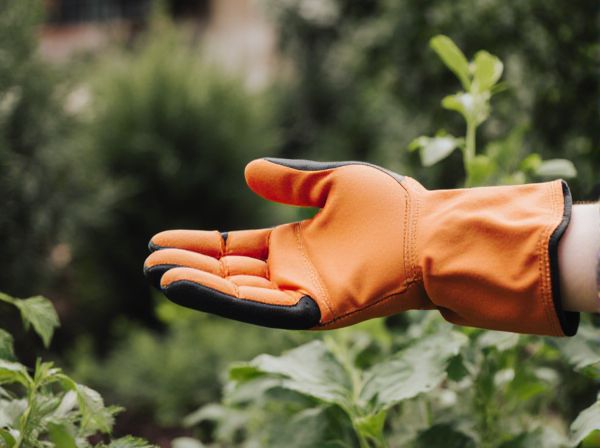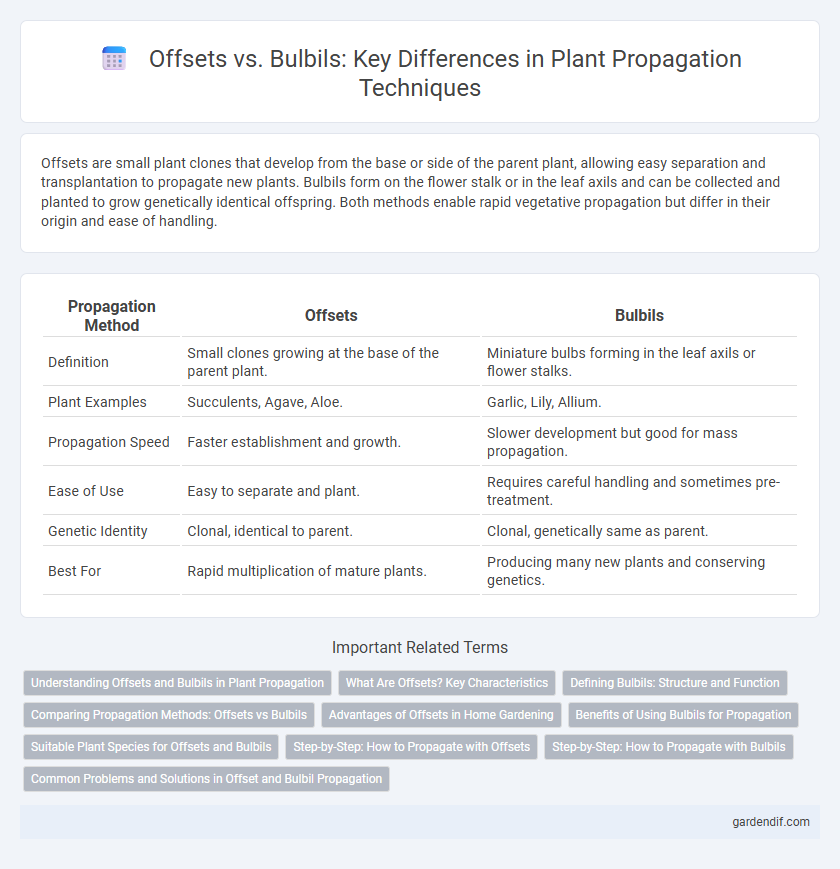
Offsets vs Bulbils Illustration
Offsets are small plant clones that develop from the base or side of the parent plant, allowing easy separation and transplantation to propagate new plants. Bulbils form on the flower stalk or in the leaf axils and can be collected and planted to grow genetically identical offspring. Both methods enable rapid vegetative propagation but differ in their origin and ease of handling.
Table of Comparison
| Propagation Method | Offsets | Bulbils |
|---|---|---|
| Definition | Small clones growing at the base of the parent plant. | Miniature bulbs forming in the leaf axils or flower stalks. |
| Plant Examples | Succulents, Agave, Aloe. | Garlic, Lily, Allium. |
| Propagation Speed | Faster establishment and growth. | Slower development but good for mass propagation. |
| Ease of Use | Easy to separate and plant. | Requires careful handling and sometimes pre-treatment. |
| Genetic Identity | Clonal, identical to parent. | Clonal, genetically same as parent. |
| Best For | Rapid multiplication of mature plants. | Producing many new plants and conserving genetics. |
Understanding Offsets and Bulbils in Plant Propagation
Offsets and bulbils are both vegetative propagation methods that enable plants to reproduce asexually, ensuring genetic consistency. Offsets are small, complete plants that develop from the base or root of the parent plant, often forming a cluster that can be separated and replanted independently. Bulbils, in contrast, are miniature bulbs produced on the aerial parts, such as leaf axils or flower stalks, which detach and grow into new plants under suitable conditions.
What Are Offsets? Key Characteristics
Offsets are small, naturally occurring plantlets that develop at the base of a parent plant, typically found in species like succulents and lilies. These clones retain the genetic makeup of the parent and can be separated and replanted to propagate new plants. Key characteristics include their compact size, basal growth position, and ability to root independently once removed.
Defining Bulbils: Structure and Function
Bulbils are small, bulb-like structures that form on the aerial parts of certain plants, often replacing flowers or emerging in leaf axils. These specialized propagative organs contain embryonic shoots capable of developing into independent plants without the need for seeds. Their compact size and nutrient-rich tissues facilitate rapid vegetative reproduction and survival in diverse environmental conditions.
Comparing Propagation Methods: Offsets vs Bulbils
Offsets provide a reliable propagation method by producing genetically identical clones through division of the parent plant's base, ensuring rapid establishment and strong root development. Bulbils, formed as miniature bulbs on the parent plant, offer a lightweight and space-efficient way to propagate, often requiring less time to produce flowering plants but sometimes exhibiting slower initial growth. Comparing these methods reveals offsets excel in durability and growth speed, while bulbils are advantageous for ease of collection and propagation of certain species like lilies and agaves.
Advantages of Offsets in Home Gardening
Offsets offer a reliable and faster propagation method for home gardeners compared to bulbils, producing genetically identical plants that ensure consistent growth and quality. They typically root more quickly and establish stronger root systems, reducing the risk of plant failure. Utilizing offsets also allows gardeners to expand their plant collection efficiently with minimal space and care requirements.
Benefits of Using Bulbils for Propagation
Bulbils offer a compact and efficient propagation method by producing clones directly on the parent plant, reducing the time and resources needed compared to offsets. Their ability to root easily without requiring specialized conditions enhances propagation success rates, ensuring rapid establishment of new plants. Using bulbils minimizes the risk of disease transmission often associated with soil-based offset growth, promoting healthier plant proliferation.
Suitable Plant Species for Offsets and Bulbils
Offsets are commonly used for propagating succulent plants such as Aloe, Agave, and Haworthia, which produce small clones around the base of the mother plant. Bulbils are ideal for species like garlic, tiger lilies, and some Allium varieties, as these small bulbs develop in place of flowers or along the stem. Selecting offsets or bulbils depends on the specific plant's reproductive anatomy and ease of separation for successful propagation.
Step-by-Step: How to Propagate with Offsets
Offsets, also known as pups, are small plants that grow at the base of the parent plant and can be carefully separated for propagation. To propagate using offsets, gently remove the offset from the parent plant using a clean, sharp knife, ensuring it has some roots attached. Plant the offset in well-draining soil, water lightly, and place it in a warm, bright location to encourage root development and healthy growth.
Step-by-Step: How to Propagate with Bulbils
Bulbils propagate by carefully detaching them from the parent plant once fully matured, ensuring they have small roots or are ready to root soon. Plant bulbils in well-draining soil at a depth just enough to cover the base, maintaining consistent moisture to encourage root development. Monitor growth regularly, providing adequate sunlight and nutrients to support healthy sprouting and eventual establishment.
Common Problems and Solutions in Offset and Bulbil Propagation
Offsets often face common problems such as poor rooting and fungal infections, which can be mitigated by using well-draining soil and applying fungicides. Bulbils frequently encounter issues like slow germination and pest infestations; these can be addressed by soaking bulbils in growth hormones and maintaining controlled humidity levels. Proper sanitation and timely pest control are essential for successful propagation in both offsets and bulbils.
Offsets vs Bulbils Infographic

 gardendif.com
gardendif.com